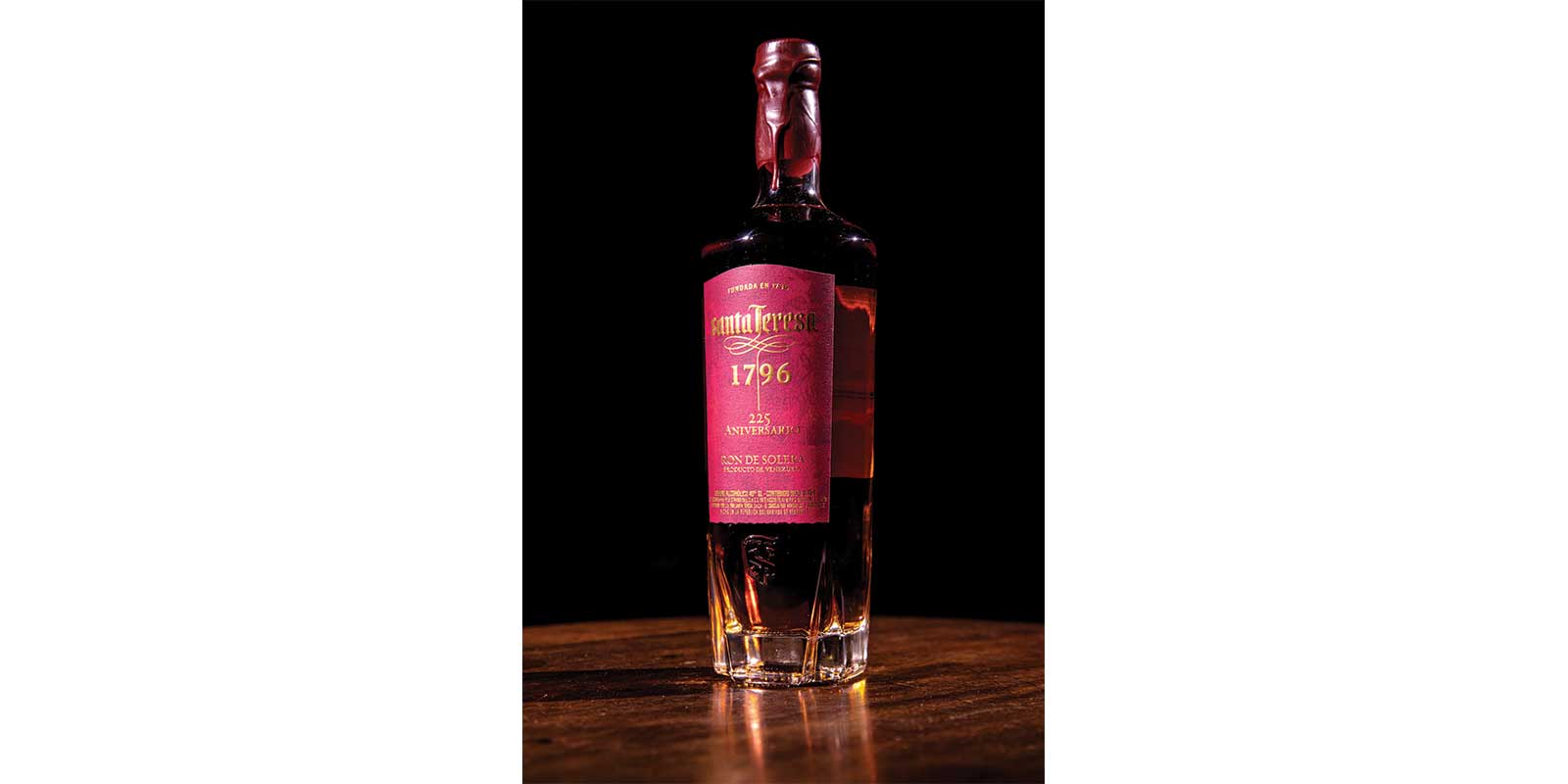
Santa Teresa 1796
Appearance
- Amber red, rich like a volcanic sunset
Nose
- Fruited aroma with wood notes
Palate
- Leather, vanilla, cinnamon, dark chocolate, nuts, prunes, and hints of honey and pepper—a beautiful combination
ood quality endures, and for something to have endured for 225 years, through revolutions, economic upheavals and countless political shifts—and for it still to be thriving today—the quality must be great indeed. So it is with the Hacienda Santa Teresa, home of Santa Teresa rum and one of Venezuela’s most enduring properties.
More than just a success story, the distillery founded in 1796 is a cultural touchstone, one that unites Venezuelans around the world and which invites non-natives to visit a rich and vibrant culture simply by raising a glass. Despite the ease with which its most beautiful products—its rums—are shared and enjoyed, the Hacienda’s journey to the modern era did not come by a carefree path. Rather, the story of the Hacienda Santa Teresa and the rum that bears its name is one of hard work done by hand, careful years of dedication to the highest standards, and long hours perfecting Santa Teresa’s take on the artisanal Solera method of rum-making. The result is a family of rums that sets the bar for depth and character, with all of the Hacienda’s centuries of experience culminating in the premium Santa Teresa 1796.
To appreciate Santa Teresa’s role in Venezuelan culture, and in the history of the New World, in fact, one must imagine Venezuela as it was in the late 18th century. While the Americans were fighting for their independence from England, the Spanish colony with jungle-covered mountains and a coast gilded with golden beaches was enjoying a robust trade economy and attracting scholars to its capital city’s music school and top university. Twenty years after the American Declaration of Independence was signed, the Hacienda Santa Teresa was founded in the mountainous Aragua Valley, just over an hour south of Caracas. The next year saw Venezuela’s first attempt at independence: a proclamation in 1797 that quickly failed but which hinted at coming change. That change came relatively soon, with a war of independence that, in various forms, lasted from 1810 through 1821, when Simón Bolívar rode into Caracas and Venezuela finally broke with Spain. Through it all, the Hacienda endured, initially as a site for coffee, cocoa and sugar cane. In 1830, however, a German merchant named Gustav Julius Vollmer came to Venezuela, met and married a woman by the name of Panchita Rivas, acquired the Hacienda and began producing rum of an exceptional quality. The Vollmer family kept the Hacienda and kept producing Santa Teresa rum over the next two centuries, through all manner of challenges, and Gustav and Panchita’s descendants run the distillery to this day, continuing the tradition begun by their ancestors so many years ago.
More than just an exceptional rum, Santa Teresa is a cultural touchstone
Those traditions include the Solera method by which Santa Teresa rum is made, a process that ensures continuity of quality and taste in every bottle (see sidebar: Solera Method). Getting it right takes a steady hand and centuries’ worth of knowledge, handed down from maestro to maestro at the Hacienda Santa Teresa. In a show of how far Santa Teresa has progressed since its earliest beginnings, this year it named its first woman maestro, or “master blender,” who will work alongside the current master blender in handcrafting Santa Teresa rum. It’s an incredible honor and a difficult position to achieve—she’s only the fifth person to be awarded the title, and it only came after 31 years with the brand, studying under previous master blenders. In Bolívar’s day this would have been unconventional in the extreme, but the Hacienda Santa Teresa has a history of pushing forward—and in at least one case, the progress has seen an unconventional effort that’s transformed a community.

In 2003, gang members broke into the Hacienda Santa Teresa and attacked a guard. An on-site security team quickly apprehended the gang members, but rather than immediately calling in the authorities, the Hacienda’s leadership gave them a choice: either be handed over to police or work at the Hacienda to make up for their crime. The gang members decided to go to work, and “Project Alcatraz” was born. Today, the program recruits gang members and rehabilitates them, teaching them life skills and giving them another chance at a future. Along with vocational training at the Hacienda, they’re offered counseling and formal education, and they’re introduced to rugby, through which they learn the values of respect, discipline, teamwork, sportsmanship and humility. A bold move, it’s a good example of the progressive outlook brought by Santa Teresa CEO Alberto Vollmer, who said of the project: “The guys from the gangs are used to risking everything. So when you give them a chance to do something positive in life and they take it, they become an extraordinary force.”
In Santa Teresa’s case, the “extraordinary force” goes beyond those in Project Alcatraz and includes all of the employees and fans of the Hacienda Santa Teresa, who have carried a legacy of quality and tradition for 225 years—with no sign of stopping. For Venezuelans at home, Santa Teresa rum is a reassuring constant, one of their country’s best products and a readily accessible symbol of endurance. For Venezuelans living abroad, Santa Teresa is a cultural touchstone, some part of the soul of the country to be shared with fellow Venezuelans and with those who, though they might not understand what it means to be Venezuelan, can at least appreciate 225 years of exceptional quality and the dedicated heart that it takes to succeed for more than two centuries. Highly recommended.
Find out more at santateresarum.com
Solera is a fractional blending process by which the finished spirit (rum, in this case) is a mix of spirits of different ages. The process has been common in the production of sherry, port and madeira wines since the mid 18th century, although it has been used to make a number of spirits as well. In the case of Santa Teresa 1796, when production begins and a bottle is drawn, younger rum is added to the original cask to top it up, thus blending with the rums that were added before. Because the original cask of Santa Teresa 1796 was never emptied, this process ensures that every bottle produced contains some of the very first 1796 cask running through it. Once a bottle is drawn, it is hand-sealed with wax and then shipped to beautiful gatherings all over the world, to be enjoyed with good friends. Old World methodology, timeless quality.
Appearance
Nose
Palate

Follow Us On


| Cookie | Duration | Description |
|---|---|---|
| cookielawinfo-checkbox-analytics | 11 months | This cookie is set by GDPR Cookie Consent plugin. The cookie is used to store the user consent for the cookies in the category "Analytics". |
| cookielawinfo-checkbox-functional | 11 months | The cookie is set by GDPR cookie consent to record the user consent for the cookies in the category "Functional". |
| cookielawinfo-checkbox-necessary | 11 months | This cookie is set by GDPR Cookie Consent plugin. The cookies is used to store the user consent for the cookies in the category "Necessary". |
| cookielawinfo-checkbox-others | 11 months | This cookie is set by GDPR Cookie Consent plugin. The cookie is used to store the user consent for the cookies in the category "Other. |
| cookielawinfo-checkbox-performance | 11 months | This cookie is set by GDPR Cookie Consent plugin. The cookie is used to store the user consent for the cookies in the category "Performance". |
| viewed_cookie_policy | 11 months | The cookie is set by the GDPR Cookie Consent plugin and is used to store whether or not user has consented to the use of cookies. It does not store any personal data. |